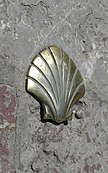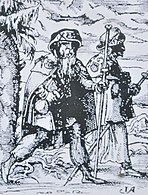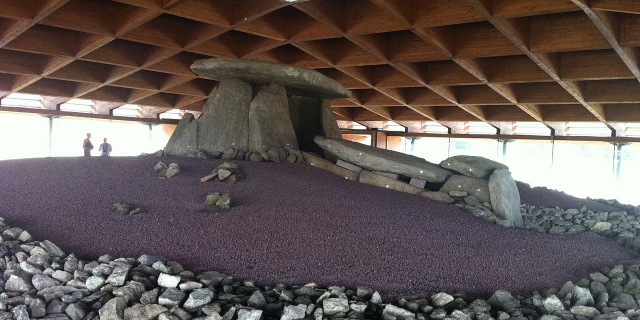The Camino de Santiago (Latin: Peregrinatio Compostellana, lit. 'Pilgrimage of Compostela'; Galician: O Camiño de Santiago), or in English the Way of St. James, is a network of pilgrims' ways or pilgrimages leading to the shrine of the apostle James in the cathedral of Santiago de Compostela in Galicia in northwestern Spain, where tradition holds that the remains of the apostle are buried.
As Pope Benedict XVI said, "It is a way sown with so many demonstrations of fervour, repentance, hospitality, art and culture which speak to us eloquently of the spiritual roots of the Old Continent." Many still follow its routes as a form of spiritual path or retreat for their spiritual growth. It is also popular with hikers, cyclists, and organized tour groups.
Created and established after the discovery of the relics of Saint Jam...Read more
The Camino de Santiago (Latin: Peregrinatio Compostellana, lit. 'Pilgrimage of Compostela'; Galician: O Camiño de Santiago), or in English the Way of St. James, is a network of pilgrims' ways or pilgrimages leading to the shrine of the apostle James in the cathedral of Santiago de Compostela in Galicia in northwestern Spain, where tradition holds that the remains of the apostle are buried.
As Pope Benedict XVI said, "It is a way sown with so many demonstrations of fervour, repentance, hospitality, art and culture which speak to us eloquently of the spiritual roots of the Old Continent." Many still follow its routes as a form of spiritual path or retreat for their spiritual growth. It is also popular with hikers, cyclists, and organized tour groups.
Created and established after the discovery of the relics of Saint James the Great at the beginning of the 9th century, the Way of St. James became a major pilgrimage route of medieval Christianity from the 10th century onwards. But it was only after the end of the Granada War in 1492, under the reign of the Catholic Monarchs Ferdinand II of Aragon and Isabella I of Castile, that Pope Alexander VI officially declared the Camino de Santiago to be one of the "three great pilgrimages of Christendom", along with Jerusalem and the Via Francigena to Rome.
In 1987, the Camino, which encompasses several routes in Spain, France, and Portugal, was declared the first Cultural Route of the Council of Europe. Since 2013, the Camino has attracted more than 200,000 pilgrims each year, with an annual growth rate of more than 10 percent. Pilgrims come mainly on foot and often from nearby cities, requiring several days of walking to reach Santiago. The French Way gathers two-thirds of the walkers, but other minor routes are experiencing a growth in popularity. The French Way and the Northern routes in Spain were inscribed on the UNESCO World Heritage List, followed by the routes in France in 1998, because of their historical significance for Christianity as a major pilgrimage route and their testimony to the exchange of ideas and cultures across the routes.
 Roman bridge with 19 arches over the river Órbigo. The bridge has been integrated into the modern Camino Francés.
Roman bridge with 19 arches over the river Órbigo. The bridge has been integrated into the modern Camino Francés.The main pilgrimage route to Santiago follows an earlier Roman trade route, which continues to the Atlantic coast of Galicia, ending at Cape Finisterre. Although it is known today that Cape Finisterre, Spain's westernmost point, is not the westernmost point of Europe (Cabo da Roca in Portugal is further west), the fact that the Romans called it Finisterrae (literally the end of the world or Land's End in Latin) indicates that they viewed it as such. At night, the Milky Way overhead seems to point the way, so the route acquired the nickname "Voie lactée" – the Milky Way in French.[1]
Scallop symbolThe scallop shell, often found on the shores in Galicia, has long been the symbol of the Camino de Santiago. Over the centuries the scallop shell has taken on a variety of meanings, metaphorical, practical, and mythical, even if its relevance may have actually derived from the desire of pilgrims to take home a souvenir.
One myth says that after James's death, his body was transported by a ship piloted by an angel, back to the Iberian Peninsula to be buried in what is now Santiago. As the ship approached land, a wedding was taking place on shore. The young groom was on horseback, and, upon seeing the ship's approach, his horse got spooked, and horse and rider plunged into the sea. Through miraculous intervention, the horse and rider emerged from the water alive, covered in seashells.[2]: 71
From its connection to the Camino, the scallop shell came to represent pilgrimage, both to a specific shrine as well as to heaven, recalling Hebrews 11:13, identifying that Christians "are pilgrims and strangers on the earth".[3] The scallop shell symbol is used as a waymarker on the Camino, and is commonly seen on pilgrims themselves, who are thereby identified as pilgrims. During the medieval period, the shell was more a proof of completion than a symbol worn during the pilgrimage. The pilgrim's staff is a walking stick used by some pilgrims on the way to the shrine of Santiago de Compostela in Spain.[4] Generally, the stick has a hook so that something may be hung from it; it may have a crosspiece.[5] The usual form of representation is with a hook,[6] but in some the hook is absent.[7] The pilgrim's staff is represented under different forms and is referred to using different names, e.g. a pilgrim's crutch, a crutch-staff. The crutch, perhaps, should be represented with the transverse piece on the top of the staff (like the letter "T") instead of across it.[8]
Medieval route history Marker of the Camino near the entrance to the Taboada Bridge, a X-Century bridge located in the Silleda Council of Pontevedra Province in Spain. The bridge is still used today by the pilgrims on their way to Santiago using the Silver Way (Vía de la Plata).
Marker of the Camino near the entrance to the Taboada Bridge, a X-Century bridge located in the Silleda Council of Pontevedra Province in Spain. The bridge is still used today by the pilgrims on their way to Santiago using the Silver Way (Vía de la Plata).The earliest records of visits paid to the shrine at Santiago de Compostela date from the 9th century, in the time of the Kingdom of Asturias and Galicia. The pilgrimage to the shrine became the most renowned medieval pilgrimage, and it became customary for those who returned from Compostela to carry back with them a Galician scallop shell as proof of their completion of the journey. This practice gradually led to the scallop shell becoming the badge of a pilgrim.[9]
The earliest recorded pilgrims from beyond the Pyrenees visited the shrine in the middle of the 11th century, but it seems that it was not until a century later that large numbers of pilgrims from abroad were regularly journeying there. The earliest records of pilgrims that arrived from England belong to the period between 1092 and 1105. However, by the early 12th century the pilgrimage had become a highly organized affair.[10]
One of the great proponents of the pilgrimage in the 12th century was Pope Callixtus II, who started the Compostelan Holy Years.[11]
The daily needs of pilgrims on their way to and from Compostela were met by a series of hospitals. Indeed, these institutions contributed to the development of the modern concept of ‘hospital’. Some Spanish towns still bear the name, such as Hospital de Órbigo. The hospitals were often staffed by Catholic orders and under royal protection. Donations were encouraged but many poorer pilgrims had few clothes and poor health often barely getting to the next hospital. Due to this, María Ramírez de Medrano founded one of the earliest hospitals of San Juan de Acre in Navarrete and a commandery for the protection of pilgrims on the Compostela route.[12]
Romanesque architecture, a new genre of ecclesiastical architecture, was designed with massive archways to cope with huge crowds of the devout.[13]
There was also the sale of the now-familiar paraphernalia of tourism, such as badges and souvenirs. Pilgrims often prayed to Saint Roch whose numerous depictions with the Cross of St James can still be seen along the Way. On the Camino, the cross is often seen with a Pilgrim's scallop to mark the way of the pilgrimage.[14]
The pilgrimage route to Santiago de Compostela was made possible by the protection and freedom provided by the Kingdom of France, from which the majority of pilgrims originated. Enterprising French (including Gascons and other peoples not under the French crown) settled in towns along the pilgrimage routes, where their names appear in the archives. The pilgrims were tended by people like Domingo de la Calzada, who was later recognized as a saint.
Pilgrims walked the Way of St. James, often for months and occasionally years at a time, to arrive at the great church in the main square of Compostela and pay homage to St James. Many arrived with very little due to illness or robbery or both. Traditionally pilgrims lay their hands on the pillar just inside the doorway of the cathedral, and so many now have done this it has visibly worn away the stone.[15]
The popular Spanish name for the astronomical Milky Way is El Camino de Santiago. According to a common medieval legend, the Milky Way was formed from the dust raised by travelling pilgrims.[16]
First official guide bookThe official guide in those times was the Codex Calixtinus. Published around 1140, the 5th book of the codex is still considered the definitive source for many modern guidebooks. Four pilgrimage routes listed in the codex originate in France and converge at Puente la Reina. From there, a well-defined route crosses northern Spain, linking Burgos, Carrión de los Condes, Sahagún, León, Astorga, and Compostela.
Legends of the discovery of the Tomb of St. JamesAnother legend states that when a hermit saw a bright star shining over a hillside near San Fiz de Solovio, he informed the bishop of Iria Flavia, who found a grave at the site with three bodies inside, one of which, he asserted, was that of St James. Subsequently, the location was called "the field of the star" (Campus Stellae, corrupted to "Compostela").[17]
Another origin myth mentioned in Book IV of the Book of Saint James relates how the saint appeared in a dream to Charlemagne, urging him to liberate his tomb from the Moors and showing him the direction to follow by the route of the Milky Way.[citation needed]
Pilgrimage as penanceThe Church employed (and employs) rituals (the sacrament of confession) that can lead to the imposition by a priest of penance, through which the sinner atones for his or her sins. Pilgrimages were deemed to be a suitable form of expiation for sin and long pilgrimages would be imposed as penance for very serious sins. As noted in the Catholic Encyclopedia:
In the registers of the Inquisition at Carcassone...we find the four following places noted as being the centres of the greater pilgrimages to be imposed as penances for the graver crimes: the tomb of the Apostles at Rome, the shrine of St. James at Compostella [sic], St. Thomas' body at Canterbury, and the relics of the Three Kings at Cologne.
Pilgrimages could also be imposed as judicial punishment for crime, a practice that is still occasionally used today. For example, a tradition in Flanders persists of pardoning and releasing one prisoner every year[18] under the condition that, accompanied by a guard, the prisoner walks to Santiago wearing a heavy backpack.
Enlightenment eraDuring the American Revolution, John Adams (who would become the second President of the United States) was ordered by Congress to go to Paris to obtain funds for the cause. His ship started leaking and he disembarked with his two sons at Finisterre in 1779. From there, he proceeded to follow the Way of St. James in the reverse direction of the pilgrims' route, in order to get to Paris overland. He did not stop to visit Santiago, which he later regretted. In his autobiography, Adams described the customs and lodgings afforded to St James's pilgrims in the 18th century and he recounted the legend as it was told to him:[19]
I have always regretted that We could not find time to make a Pilgrimage to Saintiago de Compostella. We were informed ... that the Original of this Shrine and Temple of St. Iago was this. A certain Shepherd saw a bright Light there in the night. Afterwards it was revealed to an Archbishop that St. James was buried there. This laid the Foundation of a Church, and they have built an Altar on the Spot where the Shepherd saw the Light. In the time of the Moors, the People made a Vow, that if the Moors should be driven from this Country, they would give a certain portion of the Income of their Lands to Saint James. The Moors were defeated and expelled and it was reported and believed, that Saint James was in the Battle and fought with a drawn Sword at the head of the Spanish Troops, on Horseback. The People, believing that they owed the Victory to the Saint, very cheerfully fulfilled their Vows by paying the Tribute. ... Upon the Supposition that this is the place of the Sepulchre of Saint James, there are great numbers of Pilgrims, who visit it, every Year, from France, Spain, Italy and other parts of Europe, many of them on foot.











































Add new comment